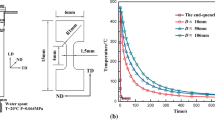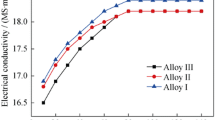Abstract
Effects of Mg and Cu content on quench sensitivity of Al–Si–Mg-based cast alloys were investigated. Jominy end-quench test was performed to evaluate the quench sensitivity of Al–Si–Mg and Al–Si–Mg–Cu-based alloys. It was observed that the quench sensitivity of Al–Si–Mg alloy rises with the increase in Mg content. In general, quench factor values rise with the increase in distance away from the chill end of Jominy end-quench test bar. This is because the precipitation rate of strengthening particles increases with the increase in the concentration of quenched-in vacancy. The concentration of quenched-in vacancy declines with the decrease in cooling rate away from the chill end of test bar. The maximum quench factor value of Al–Si–0.57Mg alloy is 144.8, whereas those of Al–Si–0.35Mg and Al–Si–0.45Mg alloys are 38.5 and 34.8, respectively. This is in contrast to the quench factor values obtained in Al–Si–Mg alloy containing 0.8 %Cu. Results show that an addition of 0.8 % Cu to Al–Si–Mg alloy significantly reduces the quench sensitivity of the alloy. Quench factor values of Al–Si–Mg–0.8Cu alloy are in the range of 1–16. No significant reduction in the quench factor is observed on addition of 0.23 and 0.50 wt% of Cu to Al–Si–Mg alloy. Simulation results show that Guinier–Preston (GP) zones form in the Al matrix when the amount of Cu in the Al–Si–Mg alloy exceeds 0.57 wt% during the natural aging subsequent to quenching. These GP zones are well-known heterogeneous sites for nucleation of precipitates and are responsible for reducing quench sensitivity of the Al–Si–Mg–0.8Cu alloy.








Similar content being viewed by others
References
C.H. Caceres, C.J. Davidson, J.R. Griffiths, L.M. Hogan, Q.G. Wang, Mater. Forum 21, 27–43 (1997)
D. Apelian, S. Shivkumar, G. Sigworth, AFS Trans. 89–137, 727–741 (1989)
Q.G. Wang, C.J. Davidson, J. Mater. Sci. 36(3), 739–750 (2004)
S.K. Chaudhury, D. Apelian, J. Mater. Sci. 41(14), 4684–4690 (2006)
S.K. Chaudhury, L. Wang, D. Apelian, AFS Trans. 112, 1–16 (2004)
J.M. Silcock, Philos. Mag. 4, 1187–1193 (1959)
C. Garcia-Cordovilla, E. Louis, Metall. Mater. Trans. A 15A, 389–391 (1984)
T. Chen, G. Phen, J.C. Huang, Metall. Mater. Trans. A 27A, 2923–2933 (1996)
K. Hirose, S. Hirosawa, T. Sato, Mater. Sci. Forum 396–402, 795–800 (2002)
L. Pedersen, L. Arneberg, Metall. Mater. Trans. A 32A, 525–532 (2001)
J. Marrow, Ind. Heat. 68(9), 57–60 (2001)
S. Ma, M.D. Maniruzzaman, R.D. Sisson Jr., ASM heat treating society conference and exposition, Pittsburgh, PA, USA, 26–28 Sept 2005
N. Saunders, Z. Guo, X. Li, A.P. Miodownik, J.-P. Schille, J. Metals 55, 60–65 (2003)
R.N. Lumley, I.J. Polmear, P.R. Curtis, Rapid heat treatment of aluminum high pressure diecastings. Metall. Mater. Trans. A 40A, 1716–1726 (2009)
M.S. Misra, K.J. Oswalt, Aging characteristics of titanium-refined A356 and A357 aluminum castings. AFS Trans. 90, 1–10 (1982)
G.A. Edwards, K. Stiller, G.L. Dunlop, M.J. Cooper, The precipitation sequence in Al–Mg–Si alloys. Acta Mater. 46, 3893–3904 (1998)
N. Saunders, The modelling of stable and metastable phase formation in multi-component Al-alloys. Mater. Forum 28, 96–106 (2004)
Acknowledgments
Authors thank the corporate members of the Advanced Casting Research Center of the Metal Processing Institute for their support of this work.
Author information
Authors and Affiliations
Corresponding author
Technical Review & Discussion
Technical Review & Discussion
Effects of Mg and Cu Content on Quench Sensitivity of Al–Si–Mg Alloy
Sujoy K. Chaudhury; Indus University, Ahmedabad, Gujarat, India
Diran Apelian; Worcester Polytechnic Institute, Metal Processing Institute, Worcester, MA, USA
Reviewer:
Regarding precipitation hardening; while it is generally correct to refer to the Mg–Si precipitation hardening system as Mg2Si based, the maximum hardness is generally achieved in the semi-coherent Beta prime and Beta double prime region. By the time the end-stage incoherent Mg2Si particles reach dominance you are in the over-aged and softened region of the aging curve. So we must be careful referring to the precipitates you see in the Al–Si–Mg alloys as all being Mg2Si in the T6 temper.
Authors:
Agreed. The precipitation sequence is discussed in the revised manuscript. The reviewer is right that metastable phases such as beta prime, beta double prime, B-prime contribute significantly to peak hardening condition. After 5 hours of aging, it is expected that the matrix will consist of combination of stable and metastable phases.
Reviewer:
What is the difference between Beta, B_Prime and Beta_Prime?
Authors:
Beta, B_Prime and Beta_prime are metastable phases formed during the initial stage of precipitation with Mg:Si ratio close to 1:1 and the nomenclature was used by Edwards etal. This has been discussed and referenced in greater detail in the revised paper.
Reviewer:
You state that GP zones do not form in A356 alloy. My understanding is that there is a sequence of reactions during aging. Precipitation starts with the formation of spherical GP zones from the supersaturated solid solution (Alss). These quickly elongate into the direction of the aluminum matrix and assume a needle shape. They grow to become rods, and eventually platelets. Peak hardness is just before platelets form. β’ is a semi-coherent phase. The final, equilibrium β phase (Mg2Si) nucleates on β’.
Authors:
The simulation result predicted that GP zones do not form during the natural aging of A356 alloy subsequent to quenching after solution heat treatment. It is a generally accepted theory that GP zones form in A356 alloy followed by precipitation of metastable at the early stage and stable precipitates at the later stage (i.e. overaging). However, the simulation result from JMatPro showed that GP zones do not form in A356 alloy irrespective of holding time after quenching from solutionizing temperature. Similar observations have been reported by Saunder and referenced in the revised paper. I agree with reviewer’s comment on the evolution metastable and stable precipitates and the same is added in the revised manuscript.
Rights and permissions
About this article
Cite this article
Chaudhury, S.K., Apelian, D. Effects of Mg and Cu Content on Quench Sensitivity of Al–Si–Mg Alloy. Inter Metalcast 10, 138–146 (2016). https://doi.org/10.1007/s40962-016-0020-z
Published:
Issue Date:
DOI: https://doi.org/10.1007/s40962-016-0020-z




